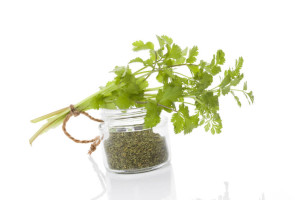 Talking of Kenya, the benefits of this spice are not just at combating numerous health conditions like eczema, diarrhea and inflammation but also the happiness it brings when you mix it well. Indeed, nutritionists have borrowed hints from gourmets across the world, particularly Asia and decided on some ways that can make your coriander leaves worth the try.
Talking of Kenya, the benefits of this spice are not just at combating numerous health conditions like eczema, diarrhea and inflammation but also the happiness it brings when you mix it well. Indeed, nutritionists have borrowed hints from gourmets across the world, particularly Asia and decided on some ways that can make your coriander leaves worth the try.
Kenya coriander as many know it usually directly refers to the fruit of the coriander but in this dissection, we refer to the leaves.
Dhania, as coriander is known in Kenya from Indian derivation makes for a fresh meal if it is put onto the table just washed and, ideally, consumed raw. Some experienced cooks normally wait until the last minute when their mutton or beef stew is simmering hot and toss the fresh leaves on top of the broth.
The reason for adding them raw at the last minute is that they retain their original aroma and spiciness to the same level they had when fully blossomed. Some people are wary of overcooking them but thanks to counsel from gourmets, there are alternatives below.
Yes, you can make your Kenya coriander leaves be the talk of the kitchen by following the Indian example of chopping up rank measures of the leaves and putting them into the dal, a popular peas and meat dish in Asia. In fact, the dhania cook as long as the rest of the meal without fear of diminishing the flavor as the time it takes does not counter the big measure of leaves already in the dish. This is especially quite popular as they have the right amount of concentrates that can keep the user happy at table as the spice outlasts its 30 minutes on fire and distills some of its flavor into the soup.
Now, which are the dishes that are popular with ranks of coriander lovers across the globe? In Kenya, coriander takes form as a spice that is mild for those who have aversion to ingredients with a high capsacain, the strong compound in chili, pepper and the like. This is why it is possible to find coriander not just in Asian restaurants in Kenya but across local homes, too.
Leaves as opposed to coriander seeds, even when the latter are full of citrus flavor, are popular in dishes across Mexico and in China. The seed which is also the fruit is popular as a dish in northern Africa, India and the Land Down Under owing to little or no oil concentration of below 0.4 percent. In Eastern Europe, people make the best of the taste by putting coriander leaves into salads including fish to make the meal retain its flavor long after the grill has cooled off.
Finally, roots of the coriander even as they appear quite light skinned in contrast to the lush green of the stem and leaves, are quite spicy. Indeed, their aroma is more diffused than that of the leaves, no wonder they are popular in Thailand as a wholesome spice in foods.
So, what is your flavor? Do you like leaves better than seeds or you prefer the roots of the coriander spice better? No matter your liking, Kenya Spices provides you with the best Kenya coriander from family growers in the highlands, all bringing you the medicinal and health benefits of the plant. One thing is for sure: you will remain one happy customer after your first taste of the coriander leaves.

